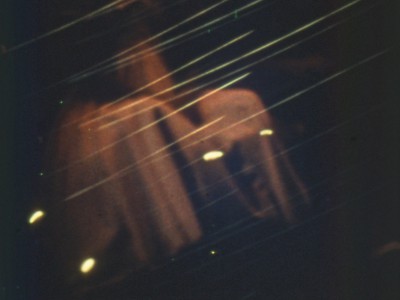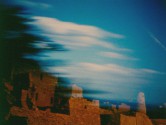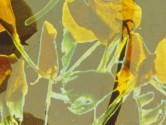Audio transcription
John Quackenbush 0:00
November 11, 2017. The Harvard Film Archive screened works by Stan Brakhage. This is the audio recording of the introductions of the programs by HFA Director Haden Guest and curator Mark McElhatten.
Haden Guest 0:18
Good evening ladies and gentlemen, my name is Haden Guest. I’m Director of the Harvard Film Archive. The title of “curator” is a much abused term all too often applied or self-appointed with little understanding of the hard work and dedication and patient study that makes curation such a true and difficult craft and art. It’s especially true, I believe, in the field of cinema. Many are called, but few are chosen to be a film curator, and I say this while mourning the loss of our beloved, our dear colleague, David Pendleton, the HFA programmer for many years, who left us all too soon this past Monday.
It is my real honor to welcome tonight Mark McElhatten, a film curator par excellence who has worked steadily as a programmer and as a curator of the moving image since the mid 1970s. At one point Mark was here in Cambridge programming at the Brattle Theatre and projecting and teaching in this very space. He's perhaps best known as a founder and curator for seventeen wonderful years of the now sorely missed Views from the Avant-Garde that was for many—myself included—an essential education in contemporary experimental cinema. While at the helm of Views, Mark worked with great skill and subtlety bringing together intuitive and deeply intelligent programs that married and invented kindred artists and films in novel and often unexpected ways. History will remember Views as a seminal, influential institution for avant-garde filmmakers, who are afforded so little stability in the fluid and capricious world of contemporary film festivals. And history will remember Mark McElhatten as a curator’s curator, a man gifted with impeccable taste and unfailing sensory memory and a flair for poetic and precise description, as you will soon learn.
Mark is here tonight to present two programs that he meticulously curated of works by and in dialogue with the great visionary filmmaker Stan Brakhage, whose cinema legacy we've been exploring in a multi-part program inspired by the re-publication, the new edition, of his influential yet long out-of-print manifesto and meditation Metaphors on Vision. Mark McElhatten has a special in deep connection with the work of Stan Brakhage, not only as a former student of the filmmaker in the 70s, but also as a curator of two major and influential brakhage programs: a ten-program retrospective at the Rotterdam International Film Festival with Brakhage in attendance and the multi-part tribute at the Torino Film Festival.
I should expand upon what I meant when I said tonight's two programs were meticulously curated by Mark, for I think this helps clarify the hard and patient work that goes into such a program. For tonight’s programs Mark not only selected each film, but also carefully selected each individual print which he personally inspected, screened multiple times, comparing different prints of the same copies until he was satisfied that the program was in order. This is the kind of care and attention that we cherish and admire here at the Harvard Film Archive, that is all too rare in this hurried age we live in. I am so thrilled that Mark is here tonight, to guide us to teach us, not only about Stan Brakhage, but also about the subtle art of curation. Please turn off any cell phones, electronic devices that you have, and please join me in welcoming Mark McElhatten for two wonderful programs.
[APPLAUSE]
Mark McElhatten 4:11
Hi, good evening. Thank you so much to Haden for that introduction with all of its affectionate exaggerations. I actually didn't get to see every print we're seeing; some I just saw this afternoon. In some cases, I looked at some titles in five or six different prints. And it was fascinating and heartbreaking. But that's a whole other story unto itself.
I'm very grateful to be here again. I love working with images and sounds, I love looking at images in the dark probably since I had conscious memory, three years old. I used to watch films and write, either the filmmaker or the actors, letters that my grandmother would answer, and it took me a while to realize what was happening there. But it's very difficult for me to be an image, a talking image, I kind of prefer to be apparitional and not frontlit, but here we are, and now, hopefully, it won't be too painful. And you'll be seeing some amazing films.
It is a great honor and thrill to be back in this particular room again. I've had so many great experiences here. Even just a few weeks ago, one of the greatest experiences was watching the Cinema Before 1300 presentation by Jerome Hiler. And that was in the course of a weekend that was devoted to the work of Jerome Hiler and Nathaniel Dorsky, but also launched the Brakhage programs that are now underway, that are commemorating this new release of a new edition of Metaphors on Vision. We saw Anticipation of the Night. Tonight we'll see The Dead. These were two key works that figured into Brakhage’s making of that period, and his thoughts that were expressed in Metaphors. But then we'll be moving into many different kinds of territories.
I want to thank Haden again, of course, and John Quackenbush, who's worked so carefully with me looking at prints over the last two days and making some decisions, and there have been a few changes in the program. One is that we'll be looking at The Dante Quartet on both programs, and we'll be looking at two different prints. And that's something I wanted to do originally. I was going to do it with a different film, but it made sense after experiencing the screenings of the last two days. So we will see The Dante Quartet just before we see The Loom on this program.
So I want to thank John, I want to think Brittany Gravely, Mark Johnson, Karin Kolb, and most especially, I want to give thanks to someone who's not here to receive it, but in memory and a remembrance to David Pendleton. I was very sad to learn that we lost him earlier this week. But last time I did see him was in this room a few weeks ago. He was a very hard working, intelligent curator of deep feeling. I found him to be a really gentle, playful soul also, and had some wonderful moments with him here in Boston, in Los Angeles, and Italy. This program, tonight's really bathed in silence, a variety of silences that allows this kind of cinema to bloom. So I won't offer a moment of silence in honor of him. But perhaps within this silence, you'll find your own moment to think of him. I'll be thinking of him during the Méliès film, Kingdom of the Fairies, because we worked on trying to find the best representation of that film and we have a restoration, hand-colored version of it. So I will be thinking of him.
And let's see, well, when I mentioned some of the experiences I've had in this room, some of the great ones were Cinema Before 1300, or seeing Robert Beavers’ Ruskin in 35 millimeter. An incredible couple of days once where Raul Ruiz presented films in double-system that had never been completed or released. And there's Forest of Bliss, the premiere. But the first experience I ever had here was in 1984, and it was somewhat accidental. I had just moved up to Boston, was living on Beacon Street, and down a few blocks one way was Saul Levine, and down a few blocks the other direction on the same street, on Beacon Street in Somerville, was Mark LaPore and I think these were both people that were probably present the first time I came to the theater. I just looked at this building and walked downstairs; I didn't know what it was, and Tortured Dust was screening with Stan Brakhage. And Tom Gunning was presenting and teaching here. And there was a kind of reunion because I had studied with both Tom and Stan Brakhage at NYU. Stan taught two classes over two consecutive summers in 1973 and ‘74. And I'd had an experience of seeing at Anthology Film Archives, Millennium and other places, maybe forty or fifty films of his already. And I had a real conversion experience with Anticipation of the Night, which maybe some of you saw a few weeks ago. That film was shown one afternoon at NYU three times in a row, and I stayed to see each screening. And I was just enraptured by it. I'd never seen anything like it. It just opened up all these possibilities. I’d never seen such handling and approach of light. That kind of cutting, a presentation of a multiplicity of aspects, all these different orders of images through different grain structures and film stocks, with a through line that just was riveting, but you could not summarize. I used to program a series I called “Films That Can't Be Told,” which means these are films that have to be seen, you can't encapsulate them, you can't really convey the essence, you have to experience it. And that's what Anticipation was for me.
And there was some hint of a vestige of a shadow protagonist in that film, although Brakhage was moving from psychodrama and away into a cinema of consciousness, and a cinema that was very visceral, and of the moment, where you felt every movement of the filmmaker. You just identified with this film that was arising in front of you on screen as a kind of living entity. And it surprised me later when I realized how dark it was, in some respects. So one of the things that's come out in the course of research and the reissue of Metaphors on Vision, some of the work that P. Adams Sitney did, letters he went back through... It's been expressed now in a way that I didn't ever understand really, because I was always so surprised at how that film arose out of the midst of Eisenhower's 50s in the Midwest, with nothing that resembled it, and it seemed like it just took enormous courage and conviction.
The truth was that a lot of peers and a kind of intelligentsia of the era was very baffled and distraught by this film; they didn't know where Brakhage was going. They kind of thought he was off the rails and needed to be rescued. So one of the things that came out in the new edition is that Parker Tyler offered to help rescue the film. And by that he meant he was willing to help supply a poetic text, a narration that would help ground the audience and clarify what was happening in this film, which of course, is completely other from how this film wants you to experience it and to experience the act of perception in the world. And also, I read something in letters not too long ago that I hadn't realized, that Amos Vogel, who was such a great curator and been presented so many things from Europe and from the American avant-garde for the first time, was afraid to present Anticipation of the Night. And he balked at doing it and he later regretted that he hadn't shown it, but he said that he always wanted to keep two steps ahead of his audience, but this film was three steps ahead of him so he couldn't find his way towards it.
So I was fortunate to study with Brakhage, and one of the first classes that he ever taught, he was speaking about and arguing about and showing us films by Méliès. And I'll tell you about that in a minute. But the thing I wanted to mention, in light of Anticipation, and a number of issues, is that there was one screening where we watched Anticipation in the Dark with Stan and he started to speak over the film, not as a lecturer, but something overcame him and it was really heartfelt. Tom Gunning later said, “It's almost as if a child was walking home in the dark alone, and had to whistle or do something to console themselves, because they were afraid. They had to create some kind of expression or companion or consolation.” That's an interesting thing, because I think in one of the films we'll see tonight, Commingled Containers, in a sense, he made that film, you know, years and years later from the time we're talking about now, in the wake of receiving a negative prognosis for cancer, bladder cancer, that was the result of having worked with paints and dyes from Iran on his hand-painted films that contained tar coal. And he was overcome, but he tried to make something that was lyrical, pitted against lament, pitted against despair. And something that was available at hand, the first body of water that he encountered, which was just this little stream that was running by the office where he taught at the University of Boulder, and he made a remarkable film. But it's interesting to think about that as an emotional response, to create something of beauty that way so spontaneously. But he often expressed things poetically, and with a certain morbidity that shocked me, and his humor was deeply dark. Sometimes it took me years, it took me twenty years to catch up with it, actually. And so this one time when we were watching Anticipation of the Night, it was almost like a benshi, you know, only a stentorian benshi. So the image on screen is a beautiful, glowing flashes of a Ferris wheel. So there's this moment with the Ferris wheel. It's kind of beautifully abstracted, but we still see the form, could almost be like a flickering chromatrope or magic lantern slide. And Brakhage looks at it, and he says, “Look, it's the mill wheels of God, grinding the children's dreams into dust.” And I'm just like, [GASPS], you know, because I thought it was the most wonderful, ecstatic image. And then later, there are children dreaming and birds and flamingos. And it just all seems like a nocturnal, idyllic scene. And he said, “The birds are pecking out the eyes of the children and disturbing their dreams.” I’m like, “Oh, my god. Okay, Stan.” So, there was that aspect to him. And it was startling to me, but this whole idea of the child talking in the dark has really taken hold, most recently, when I read Jane Brakhage's biography of the story of Stan's life, which really all comes from stories he told but it's through her organization and her voice, probably much clearer and more resonant than how Stan would have related it. But it had enormous impact, and it provided a kind of key. I mean, one shouldn't always look towards autobiography or personal information to look at a film, but that's something Stan did himself, quite a bit. So I'm going to read something in just a second that I found in a letter to Annette Michelson where Brakhage was writing about Méliès. But he was very preoccupied with Méliès in the early 70s, in his teaching and his writing. And of course, he put out a book of the Chicago lectures around 1972 that included biographies, in a sense, of Méliès, of Carl Dreyer, Eisenstein, and I'm trying to think who else... It'll come to me, But Stan was interested in Eisenstein and all of his films but also some of the footage that Jay Leyda had helped organize and Jay Leyda was also teaching at NYU at the time, and I heard from P. Adams that one of the things that he said about reading these biographies, he says, “Why is Brakhage making up all these fantastic details about their lives when their lives were already unbelievable?” And it is something that Stan did, he worked with fact and fiction, and yet he would often come up with a very deep reading, a deep understanding of the work of those filmmakers, and creating sometimes a bit of a fable, but something that was deeply insightful at the same time, that rang true.
So recently, I came upon a syllabus for a class he taught in Chicago in spring of ‘75—so it's already a little bit late—nd the first film that he's showing on February the 3rd, 1975, is El espectro rojo, which he credits to George Méliès. Now, that was not a Méliès film. It's a greatly beloved film. I think a lot of people appreciate that film and its maker, Segundo de Chomón. But in fact, in 1975, the film usually was misattributed, it was misattributed to Ferdinand Zecca at Pathé, but not Méliès. But Stan had decided that it must be a Méliès film, because it has a kinship with that work. And he maintained that the title El espectro rojo came via Mexico. Of course it was the Spanish title and Segundo de Chomón was Spanish. He had worked with Méliès at one point, and then they became rivals. And I think in many ways, I'd have to say, he surpassed Méliès, to my mind, in terms of his imagination and individuality and reach, but Méliès was a great artist unquestionably. But I listened to the lecture. And you hear Stan start to inject all of his personal details about Méliès as he says, “Okay, that woman is probably his wife,” and he creates this whole personal allegory that corresponds to what you're seeing, and it's not really true, and yet it's deeply expressive. And, again, insightful in terms of looking at Méliès’ work. So that was just one of the paradoxes but an interesting one…
So I just wanted to say a few things about Méliès in relation to Brakhage, and then we'll start the program. I didn’t want to delay that too much. But from his letter to Annette Michelson in 1972, he writes, “Alright, then, along came George Méliès who we’ll now credit as the first essential Innovator of film, meaning that he was the first whose very essence is effect cut of his own disturbed image and inner image to nature. George, artist as magician, showed a world of film. His films were so reflective of his most personal state of nerves, so effectual thus as to avoid affectation altogether. And as usual, in these cases, he was solidly grounded into a specific tradition of the arts at large. He grew within a very intellectually fenced field of consideration to discover the intrinsic possibilities of the art of film.” Okay, “The Symbolists, even the Pre- Raphaelites, gave him his ticket straight back to the major Western perspective crisis of the birth of the Renaissance. Thus George, finally, taking unto himself the whole intellectual history of art.” Quoting Heraclitus, Brakhage writes, “Let us therefore, notice that each understanding is common to all men. Understanding is common to all, yet each man acts as if his intelligence were private, and all his own. Knowledge is not intelligence.” Okay, and he goes on to talk about how personal and tortured and expressive Méliès work is, as if Méliès is making, kind of, psychodrama, the way Brakhage made psychodramas in an earlier period. And he said, “To illustrate this particular angst of creation, Michelangelo's image of his own flayed skin painted into the hands of the traditional saints, marching on through religious history to the far wall of the Sistine Chapel, George Méliès’ art proclaims itself as such. He acted, too, as if his intelligence were private, and all his own, but he acted within the privacy of the world.”
So now I just wanted to read quickly—kind of in response to that—from two writings that appeared in different periods of time in Senses of Cinema, one from 2014, from Darragh O'Donoghue, and one that had to do with Méliès and color, by Wendy Haslem. But I should just mention, because I brought up that first class that I was in with Stan, he got into an intense argument with a student about whether Méliès was essentially personal, innovative and cinematic. And the student kept arguing, because they had read a bit, that everything we're seeing comes from a certain kind of stagecraft, stage machinery, and repertoire of effects that belong to the magic theatre and the Robert Houdin Theatre, where Méliès had started as a stage magician, and had actually purchased that theater later on. And Stan kept arguing, “No, no, no, it goes beyond that. I mean, look at what's happening with superimpositions, with dissolves, with his approach to building things in space, with the recurrence of certain themes that are choreographed in a particular way, or create a particular geometry with the envisionment of women in the forms of desire, but also an alternate form of vanquishing magic that defeats inferior magics.” And the student wouldn't give up. And finally, Stan just went, “You're right.” And he conceded because he thought it was ridiculous to go on. At that point, laughter came out of the back of the room, and I looked back, and I was really surprised to see Sidney Peterson, the great filmmaker, in the back of the room kind of offering Stan a form of support in the form of sarcastic laughter.
But one of the things that Brakhage was very concerned with, was that he felt that there was this intrinsic integrity to the rhythm. To the rhythms, the way light was modulated, the way certain patterns were distributed, to the way things appeared and disappeared, bubbled up on screen. And to illustrate this, he often would take a Méliès film and rack it out of focus. And we would watch the entire film out of focus, and it was kind of wondrous and strange, and it did illustrate a lot of his points. Now, the kind of prints that were available at the time, and the kind of prints that Stan collected and used for his classes usually came from Blackhawk Films. They’d have English titles. They weren't hand-colored. They often were many generations away. But they were still powerful. And we have a print here tonight that's a Blackhawk print, very much of that ilk. And one thing I wanted to do in this program, we'll look at an excerpt from Baron von Munchausen’s Dream for about three or four minutes. And you shouldn't be alarmed, but you'll be seeing luminous globules and ectoplasmic spiders, and just different emanations of light on screen, instead of being able to recognize all the characters, because I wanted to try to recreate the way Stan used to show those films.
I think at this point, maybe, I won't read everything I have here. And we'll just look at the work. We also have, as I said, The Kingdom of the Fairies, which is a fairly early film by Méliès, given that he made close to 500 films. Many of them are lost, but many things have been rediscovered in the last fifteen years, even. There might be as many as eighty films that have come to light. I don't know if all of them will come to light. If you think about Brakhage’s filmography—depending on how you count the work—if you count every film in a series, he made over 450 films.
But one thing that I should mention, because it relates to The Dead, which we'll see, is Brakhage’s feeling for superimposition that came from work that he had seen recently, just before the making of this film, and deeply held convictions about trying to create another kind of cinematic space that didn't conform to the way things are normally represented, that had an affinity with some of Méliès’ work and also with films by Ian Hugo that he had recently witnessed, including Melodic Inversion. Brakhage had travelled to Belgium for a film festival, where he showed five works. And Ian Hugo was there and showed the film Melodic Inversion, and Brakhage was deeply impressed with it. And he went back to Paris before returning to the U.S., and Kenneth Anger was in Paris, and Kenneth took Ian Hugo, Brakhage and Marie Menken on a trip to the Père Lachaise Cemetery—where, in fact, Méliès is buried, Racine, Chopin... There are incredible statuary there. I remember filming there once and I got very alarmed because I thought the statuary was moving but there was actually cats that had been still. But, you know, Brakhage was very, very taken with it. I always thought that he had made the film on his first encounter with a cemetery but in fact, he returned on a subsequent trip. And one of his goals was just to return there and make a film and of course, you'll see Kenneth Anger in the film. But he made a statement, Stan, about superimposition. And this comes from a conversation he had with Philip Taaffe called “Composite Nature.” It was published in 1988. And the discussions took place in September of ‘97 in Boulder, Colorado. And Brakhage says, “The best talismanic line I have for superimposition comes from Charles Olson: ‘Two eyes in every head, to be looked out of.’ I get that because my eyes go in different directions. In the morning, I’m wall-eyed. There's a weakness in the left eye. Therefore I grew up not having just one vision, but two, quite often. Every time I'd get excited or tired or drunk, right away my eyes, particularly the left eye, just drifts. Then that led to me to perceive in double. I'm also consciously involved with trying to perceive not only what I'm remembering, but how I'm remembering it. It's all drifting there, like my grandmother drifting. Now somewhere between my two eyes and their slightly different vision, what's coming up in memory is drifting too. There's no way to represent that, except for superimposition of A, B, C. Three film rolls, and sometimes I've gone up to six rolls of film.” It's interesting, because Brakhage’s whole sense of space, in a way is predicated on some of the physical properties of his own eyes—peculiarities and limitations and ways that he really approached seeing through visual exercise to strengthen ways that he saw. But like any artist, there is a very strong physical reality to how they see the world. And he often was not responsive to things that tried to represent conventional, three-dimensional space. He had a really strong dialogue, and a good rapport with a filmmaker like Ken Jacobs, particularly in the 80s, I would say, but he could never quite respond to the work that Ken Jacobs was doing that involved 3D, or 2D-plus. So he'd look at some of the Nervous System works. He would respond to hallucinatory aspects of it, secondary imagery, but not the way that space was being formed or invoked. And even in some of Jacobs’ films where he shot—and it's not 2D per se, but he has such a understanding of volume and apparent motion that you get the strongest influences of 3D—Stan was kind of insensitive to it, and he would say, “I don't really understand what he's doing. I don't think he shoots film very well. That's not his forte. He's a great artist, but it just wasn't available to him.” And conversely, there were times where Ken Jacobs would look at Brakhage’s work—and he admired him greatly—but he couldn't respond to certain rhythms or decisions about how to use black leader or things that he felt were interfering or frustrating. And that's often the case in a dialogue between two artists, even when they admire each other. They can’t always completely share the same vision or appreciate all aspects of what another's doing.
But I've always been enthralled with superimposition, lap dissolves bi-packing—even the way that it appears in Hollywood films like Mamoulian’s lap dissolves, or Delmer Daves’. And I always see a kind of optical eroticism, you know, these two surfaces touching each other merging, sometimes creating a composite space. But other times, there is a layering that feels very dimensional. And I think you see that in The Dead. So as much as Brakhage has described things in a particular way that relate solely to his eyes, or the ways in which he was picking up on things that other artists were doing like Ian Hugo, etc., there's something very unique happening here, and a very unique kind of space. There's a relationship, I think, with the kind of space that you see in some parts of Hart of London by Jack Chambers, where he's literally superimposing two moments or an image that's very close to one another. They're not two different images. They're like an interval in time, or a kind of misregistration of something appearing over itself. Nina Fonaroff, in Department of the Interior, also worked with that really beautifully. And undoubtedly, they were both deeply influenced by The Dead. So superimposition is a kind of idea that’s at play through some of these films, so I just want to bring that up as well.
There's too much to say, and I've already said too much. So maybe we'll stop here. I hope that you come to the next program as well. As I just mentioned, The Dante Quartet will be shown in both programs. I did want you to experience two different prints of the same film, and I also think it's just so illuminating to see a film twice. Actually, when I was at NYU, every professor showed every film twice, and I saw Scorpio Rising twice. Kubelka showed everything twice when he taught there. Rio Bravo we'd see one week, and then it would repeat the next week, and we would just be floored at all the details, things that we had missed. I was struck sometimes because Brakhage would often show a film and say, “I've seen this film fifty times, and this is the first time I've noticed….” And I remember the first time he did that, it was Blood of a Poet by Cocteau because I've never noticed there's a male and female shoe outside the door of the hermaphrodite’s hotel room. And I'm looking at this image and I go, “What else would you be looking at?” but who’s to say? It was a complete revelation to him at the fiftieth viewing. So I'm happy that some of you will be seeing some of these films tonight for the first time and I know others will be seeing them for the tenth or the fifteenth time, and it should be very special for all tonight and I'm very happy to be here with you sharing this and hope you enjoy it. Thank you.
[APPLAUSE]
John Quackenbush 41:29
And now Haden Guest to introduce Part Two of the Stan Brakhage program.
Haden Guest 41:35
Please join me in welcoming back Mark McElhatten to introduce the second of tonight’s Stan Brakhage programs.
[APPLAUSE]
Mark McElhatten 41:41
Thank you all for staying for this program. And as I announced earlier, we will be seeing The Dante Quartet at the end of the program in its entirety. I did intend for that to happen in the last screening but actually I think it was good that that didn't happen, in a certain way. So you'll see that now.
Two Seconds, 1929 Mervyn Leroy pre-Code film with Edgar G. Robinson. At the beginning of the film, there's a cub reporter, with reporters assembled around an electric-chair execution. Edward G. Robinson’s in the electric chair and the nervous cub reporter asks about what will happen and how long does it take? And someone says, “Two seconds, but it's the longest two seconds that he’ll ever experience.” You know, he'll see his whole life again. And then you hear the current of the electricity hit, and it starts to conduct its way through the film because the film immediately flashes back. I think there's something maybe with a radio buzz, but constantly shot-to-shot, that electricity travels through each scene and manifests itself in a different way, like sizzling on a grill or riveters or street noise or maybe gets transformed suddenly and it's like there's an electrical surge that gets conducted through one of the gestures of the actors. Until at the end of the film, Edward G. Robinson's hysterical and explosive in this plea for his life, which actually kind of surpasses—not in pathos, but hysteria—a kind of court defense, of say something like Peter Lorre in M. And then it cuts back and [MAKES WHIRRING SOUND] and he's executed and the film ends. And I was always amazed at the different properties in the way that that sound traveled through each scene. I hadn't seen a film that had done that before. But I started to think about what that meant. So when I looked at a film by Powell and Pressburger, I Know Where I'm Going, I felt something similar was happening. It's not part of the theme of the film in any way. But you feel this current and it's there in a ball that rolls across a carpet, and a little girl crawling in the beginning and it transfers to breeze rushing through a window and rustling a curtain or a whirlpool within a tempest. An emphasis of a lyric line when the actor translates from the Gaelic what a lyric is, and he's like, “You're / the one / for me!” And then it goes into another beat in the next shot, and it just keeps conducting until the end where there's this incredible prophecy that fulfills itself in a way that's completely unexpected and exuberant, and the film ends.
Now one thing, whenever I watched Murder Psalm, I've experienced [it] that way—that there's this incredible manifestation of energy that's coursing through every shot. You're seeing material of completely different kinds of film, things taken off television, things that Brakhage shot himself, educational films, a film that has some parallel to the Little Red Riding Hood story, but it's about a young girl, there's cartoons, just a crazy Frankensteinian montage, the way that all films are only this is very overt about all the different things it's made up of. And yet it reaches a summation and it conducts itself throughout, where this energy is just coursing to the point where when the film finally ends, and you just see scratched into the film, carved into the film, “By Brakhage,” that energy’s there, going off like that. You know, it's an incredible thing. And I know when I first saw Riddle of Lumen in the 70s, at Anthology Film Archives, I was with a friend and we're just like, “Nobody, no one does that.” You know, every tremor of movement, every transition of a color to another color, every scintilla of light, no matter where it moves you across the frame, you can feel this concentration of energy and purpose. I always think it's amazing when you go to a Q&A and someone says to the filmmaker, “Oh, I saw this…. Did you intend for that to happen?” Well, of course, if it's onscreen, they intended for it to happen. They reckoned with it, even if it was an accidental energy. They took it into consideration. But the way that Brakhage does that, I think, is just unsurpassable. And that's maybe the only thing I wanted to say in this screening. There's a lot of other things I could talk about but because the other screening ran late and you're all here, I think, to see films. I'd like you to have that experience and not tamper with it, but I just wanted to convey that feeling about about Brakhage, and the the way that he sculpts each moment, the way energy discharges, the way every single aspect of things that even look like things that would be throw-away and not used in some other film are completely considered and expressive. Okay, that might be it. Okay. Thank you.
[APPLAUSE]
©Harvard Film Archive









